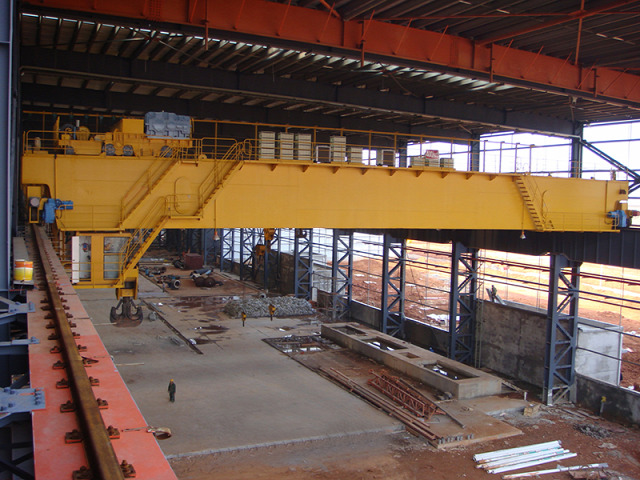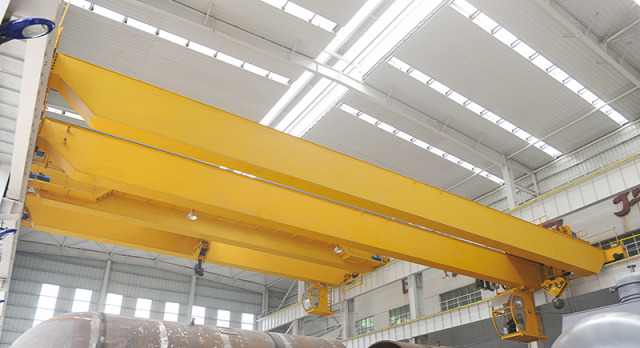An overhead bridge crane is an essential piece of industrial equipment designed to facilitate the lifting, moving, and lowering of heavy loads in manufacturing plants, warehouses, and other industrial settings. It’s a type of material handling equipment that operates on an elevated runway system, enabling horizontal movement of loads over a specific area. Overhead bridge cranes play a vital role in industries where the efficient transportation of materials is necessary, such as automotive manufacturing, steel production, construction, and shipbuilding.
In this article, we will explore what an overhead bridge crane is, its components, how it works, and the different types available in the market.

Components of an Overhead Bridge Crane
An overhead bridge crane consists of several key components that work together to ensure smooth, safe, and efficient load handling. Understanding these components is crucial to grasping how the crane operates.
-
Bridge: The bridge is the main horizontal structure of the crane, spanning the width of the area that requires coverage. It consists of one or two girders (beams) that run between the end trucks. The bridge moves along a runway system, allowing for horizontal movement of loads.
-
Runway: The runway consists of a pair of rails or beams along which the bridge travels. These rails are typically mounted on the walls or supported by columns of the building. The length of the runway determines the range of motion of the overhead travelling crane.
-
Hoist: The hoist is responsible for lifting and lowering the load. It is mounted on the bridge and moves along it to position the load where needed. The hoist can be electric, hydraulic, or manual, depending on the crane’s capacity and application. It typically uses a wire rope or chain to lift the load.
-
Trolley: The trolley carries the hoist and moves along the bridge girder. It allows the hoist to travel horizontally, providing movement in the X-axis. The trolley and hoist combination gives the crane full mobility across the area of operation.
-
End Trucks: End trucks are the structural components mounted on either side of the bridge, connecting the crane to the runway. They house the wheels that allow the bridge to move along the runway rails.
-
Controls: The control system can be operated manually, via a pendant control, or remotely. In modern overhead bridge cranes, remote control systems are often used to enhance safety and efficiency. The controls enable the operator to lift, lower, and move loads in multiple directions.
-
Electrical Components: Most bridge cranes operate electrically, meaning they rely on motors and electrical components to power the hoist, trolley, and bridge movement. The system includes wiring, power supply, and circuit boards for smooth operation.

How Does an Overhead Bridge Crane Work?
The operation of an overhead bridge crane involves coordinated movements of the crane's components to lift, transport, and place loads. Here’s a step-by-step look at how an overhead bridge crane typically works:
-
Lifting the Load: The hoist, mounted on the trolley, is responsible for lifting the load. The load is typically attached to the hoist via slings, hooks, or other lifting attachments. Depending on the hoist type, an electric motor or hydraulic system powers the lifting mechanism. Once the operator engages the control system, the hoist lifts the load vertically.
-
Horizontal Movement: Once the load is lifted to the desired height, the trolley moves along the bridge to position the load over the designated area. The movement of the trolley provides horizontal mobility in the X-axis.
-
Bridge Travel: For larger movements across the facility, the entire bridge moves along the runway. This provides a greater range of horizontal movement, covering the length of the work area in the Y-axis. This combined movement of the bridge and the trolley allows the crane to transport materials over a large space.
-
Positioning and Lowering: When the load is in the correct position, the operator lowers it using the hoist. The load is carefully lowered onto its intended location, and the crane is then ready to handle the next task.
Types of Overhead Bridge Cranes
Overhead bridge cranes come in several types, each suited to different applications and operational environments. The two main types of overhead bridge cranes are:
-
Single Girder Bridge Crane: In a single girder crane, the bridge consists of a single beam (girder), which supports the hoist and trolley. Single girder cranes are ideal for light to moderate lifting tasks, with capacities ranging from 1 to 20 tons. They are cost-effective, easier to install, and require less headroom, making them suitable for facilities with lower ceilings.
-
Double Girder Bridge Crane: In a double girder crane, the bridge consists of two girders. This type of crane is used for heavy-duty lifting applications, with capacities that can exceed 100 tons. Double girder cranes provide greater stability, lifting height, and load capacity compared to single girder cranes. They are typically used in industries like steel manufacturing, shipyards, and large construction projects.
Key Benefits of Overhead Bridge Cranes
Overhead bridge cranes offer several advantages that make them indispensable in modern industrial settings. Some key benefits include:
-
Increased Efficiency: Bridge cranes can transport loads quickly and efficiently across large spaces. This improves workflow and productivity in operations that involve heavy material handling.
-
Enhanced Safety: Bridge cranes help reduce the risk of workplace injuries by minimizing the need for manual lifting and transport of heavy objects. Additionally, modern cranes are equipped with safety features like overload protection and emergency stop systems.
-
Space Optimization: Overhead bridge cranes utilize overhead space, leaving the ground area free for other operations. This is particularly important in warehouses and manufacturing plants where floor space is valuable.
-
Customizable: Bridge cranes can be customized to suit specific operational requirements. From load capacity to the type of hoist, control system, and environmental conditions, the crane can be tailored to fit the needs of the business.
-
Durability: Built from robust materials, overhead bridge cranes are designed to withstand tough industrial environments and heavy workloads, ensuring longevity and reliability.
Conclusion
An overhead bridge crane is a powerful tool for lifting and moving heavy loads in a wide range of industrial applications. Its combination of vertical and horizontal movement allows for precise load positioning, while its various components work together to deliver smooth and efficient operation. Whether you choose a single girder or double girder crane, the flexibility, safety, and productivity offered by bridge cranes make them an essential asset in modern material handling.
By understanding the components, working mechanisms, and types of overhead bridge cranes, businesses can better select the right crane for their operations, ensuring safe and efficient material handling while improving overall workflow.

